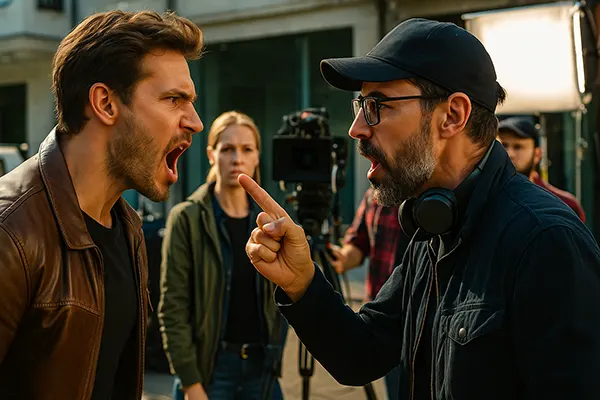
Hollywood Set Scandals: Why 2025 Became a Record Year for Conflicts
The year 2025 has marked a dramatic turn in the Hollywood film industry, witnessing an unprecedented surge in conflicts between actors and directors on set. The reasons behind this phenomenon are multifaceted, ranging from overburdened schedules to growing demands for higher pay. In this article, we will explore the key scandals that have shaken the entertainment world and examine the factors contributing to this turbulent year.
High-Profile Disputes Between A-List Actors and Directors
One of the most striking trends of 2025 has been the increasing tension between top-tier actors and filmmakers. High-profile clashes have emerged on several major productions, often leading to significant delays or even the halting of filming. Such conflicts are usually triggered by creative differences or dissatisfaction with working conditions.
A particularly publicized incident occurred on the set of the blockbuster sequel to a famous superhero franchise. The lead actor, known for his meticulous preparation, reportedly clashed with the director over changes to the script. The dispute escalated to the point where producers had to intervene, causing a two-week production halt.
Another notable case involved a celebrated director walking out of the set after a heated argument with the film’s leading actress. The disagreement stemmed from the actress’s refusal to perform a scene as scripted, citing safety concerns. The fallout led to a reshuffling of the crew and adjustments to the filming schedule.
The Impact on Production Timelines
These high-profile conflicts have inevitably disrupted production timelines. The financial implications are substantial, as delays often lead to increased costs, particularly when rescheduling scenes or bringing in new crew members. Studios are increasingly forced to allocate emergency budgets to cover these unexpected setbacks.
Moreover, public perception can be significantly affected when news of on-set turmoil reaches fans. Social media platforms become rife with speculation, often distorting the reality of the situation. As a result, studios must carefully manage public relations to mitigate the potential damage to a film’s reputation.
To address these challenges, some studios are adopting new conflict resolution protocols. These include setting clear boundaries during pre-production meetings and employing mediators to handle disputes before they escalate.
Why Are Celebrities Becoming More Demanding?
The surge in conflicts during 2025 can be partly attributed to changing dynamics within the entertainment industry. Celebrities are increasingly aware of their value and are leveraging their influence to negotiate better terms. This trend is driven by the growth of social media, where actors can directly connect with fans and gain public support.
Moreover, the post-pandemic film industry has intensified competition for prominent roles, making stars more assertive about their creative input. As studios seek to recover from past financial losses, they often push for faster production schedules, leading to stress and burnout among actors and crew members alike.
Additionally, the increased focus on personal branding means that actors are more cautious about how they are portrayed on screen. This heightened awareness can sometimes clash with a director’s vision, especially when controversial or challenging scenes are involved.
The Role of Social Media in Amplifying Conflicts
Social media has played a crucial role in both escalating and exposing on-set conflicts. In many cases, disputes that would have remained private now become public spectacles within hours. Platforms like Twitter and Instagram provide celebrities with a direct channel to share their side of the story, often prompting public debates.
Some actors have taken to social media to clarify their stance, while others have called out unfair treatment, causing waves of support or criticism. This phenomenon has made studios more cautious, as any conflict can quickly turn into a public relations crisis.
To curb the influence of social media on internal disputes, some production companies are introducing stricter non-disclosure agreements (NDAs) and encouraging conflict resolution through professional channels rather than public platforms.

Financial Implications and Studio Responses
The financial ramifications of these conflicts are significant. When production is disrupted, costs can skyrocket due to overtime payments, extended rentals of filming locations, and compensation for delayed release schedules. Some studios have even resorted to insurance policies specifically covering conflict-related delays.
Studios are increasingly focusing on preventive measures, including mental health support for cast and crew, stress management workshops, and clearer contracts that outline expectations. These initiatives aim to reduce the pressure on both actors and directors, fostering a more collaborative working environment.
Another approach is to incorporate contingency plans in production budgets, allowing for flexibility in case of unforeseen disputes. Such foresight has proven invaluable in maintaining project timelines and financial stability.
Lessons Learned from 2025
The record number of conflicts witnessed in 2025 has taught the industry valuable lessons. First and foremost, the importance of communication between cast and crew cannot be overstated. Establishing open dialogue early in the production process can help mitigate misunderstandings.
Additionally, studios are recognizing the need to balance artistic ambition with practical realities. Pushing the limits without considering the well-being of the people involved often backfires, leading to costly and highly publicized disruptions.
Finally, fostering a supportive and respectful workplace culture has emerged as a priority. As Hollywood moves forward, addressing the root causes of these conflicts will be crucial in rebuilding trust and ensuring smoother production processes in the future.
